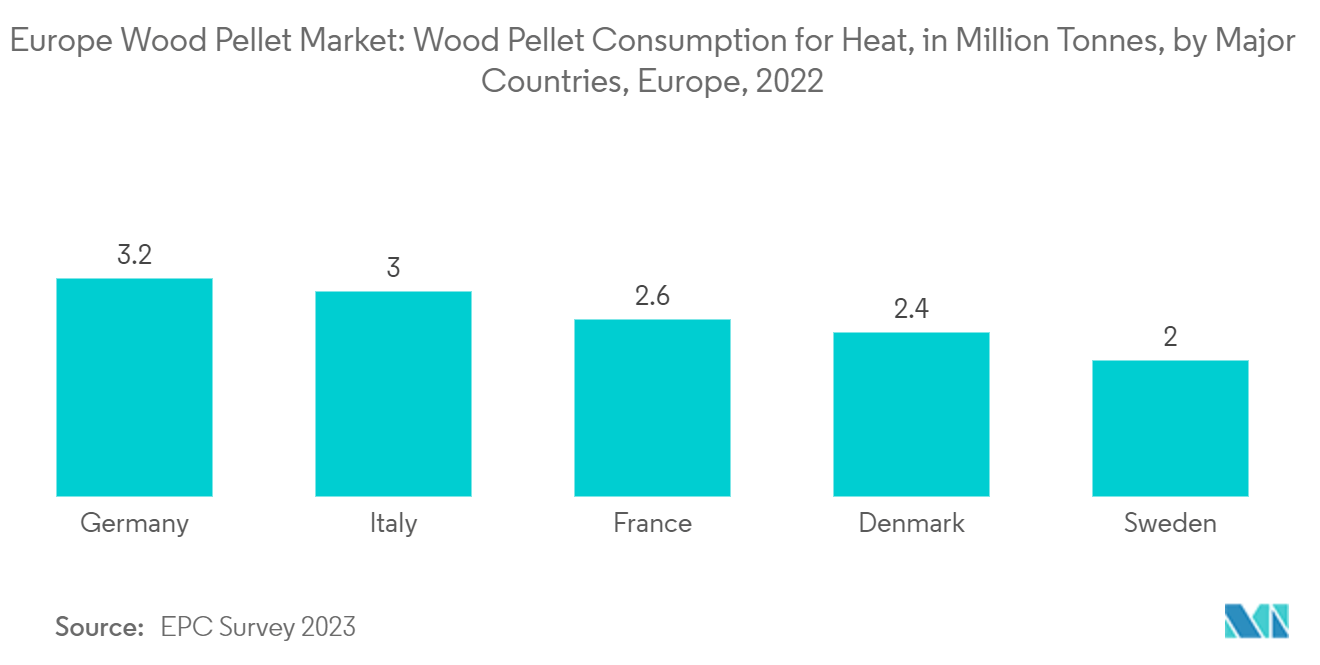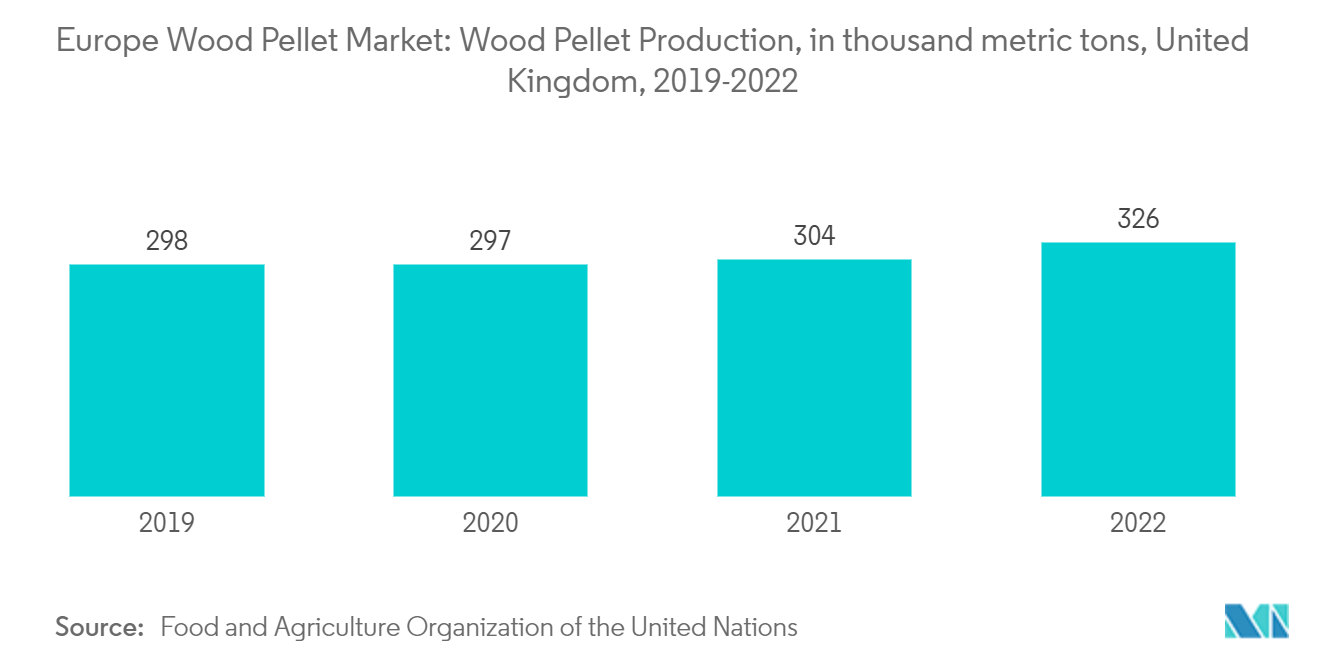Market Trends of Europe Wood Pellet Industry
The Heating Application Segment is Expected to Dominate the Market
- Wood pellets for heating applications are primarily used in residential and commercial sectors for food, cooking and grilling, and supplying heat to homes. These wood pellets, along with connected pipes, boilers, and heating radiators, are used to build heating systems at home. For heating proposes, several systems using wood pellets include pellet central heating boilers, pellet stoves, and pellet central heating stoves.
- The heating application segment of the European wood pellet market is expected to generate significant demand due to the rising consumption of wood pellets, especially in Germany and France. Europe is the largest global wood pallet market. In 2022, the region’s total wood pallet consumption accounted for 24.8 million metric tons (MMT). According to the European Commission’s (EC) mandates and incentives by EU Member States (MS), demand was expected to further expand to 25.6 MMT in 2023.
- The increasing demand for wood pellets for residential heating purposes is expected to fuel the market's growth in the future. Residential uses include domestic stoves and dedicated heat boilers with a capacity below 50 kW. Small-to-medium-scale commercial use with more than 50 kW capacity includes heat boilers used in residential and public buildings.
- Wood pellets can be used as a home heating fuel in biomass boilers or special pellet-burning stoves. Pellet stoves are better than traditional open-wood fireplaces as they burn cleaner with less smoke and soot. As the wood pellets are highly dense and contain low moisture content (lower than 10%), the pellets can burn in the stove at a very high combustion temperature with improved efficiency and much lower ash content (less than 2%) than conventional firewood.
- Using wood pellets for heating is an alternative method of reducing electricity bills. Consumers in Europe are looking for alternative ways to heat their homes following higher fuel bills.
- According to the Stove Industry Alliance, wood logs are the cheapest domestic heating fuel, costing households 74% less per kWh than electric heating and 21% less than gas heating. Such benefits of wood pellets are expected to increase their demand in heating applications during the forecast period.
- Germany, Italy, France, Denmark, and Sweden are the major countries that use wood pellets for heating purposes. According to the EPC Survey 2023, Germany used the highest amount of wood pellets for heating purposes in 2022, which accounted for 3.2 million tons.
- In Germany and Italy, more than 70% of heat generation from wood pellets was used for residential heating, while in Denmark and Sweden, pellets were used mostly for CHP heat. The climate plays an important role in the consumption of wood pellets. As the climate of European countries is expected to have colder seasons in the future, the use of pellets for heating purposes is expected to increase during the forecast period.
- Therefore, the heating application segment is expected to dominate the market during the forecast period.

The United Kingdom is Expected to Dominate the Market
- The United Kingdom uses pellets in numerous applications, such as residential heating, power plants, commercial heating, and combined heat and power plants. Pellets have also made their way into coal conversion projects in local authority buildings and public administration buildings such as schools and offices.
- As of 2024, most of the co-firing power stations have either closed or converted, with several shifting toward using 100% wood pellets for fuel. The largest of these is Drax Power Station in North Yorkshire. It has converted four of its six 65 MWe generating units to run exclusively on wood pellets.
- The Drax power plant is the country’s largest, producing around 5% of the United Kingdom’s total electricity in 2023. It is also the world’s largest biomass-fired power station, taking in around 6.5 million metric tons (MT) of pellets each year and making up the vast majority of the country’s annual pellet imports. The company also has 17 pellet plants located in the United States and Canada, which supply raw materials to its power station.
- However, according to the UK government, the country imported 6 million metric tons of wood pellets in 2023, compared to 7.52 million metric tons in 2022 and 9.13 million tons in 2021.
- According to the Food and Agriculture Organization of the United Nations, the country's wood pellet production was about 326 thousand metric tons in 2022. The production of wood pellets witnessed significant growth of about 7.2% compared to the previous year.
- In December 2023, the UK government announced its plans to extend the CfD program to support bioenergy with carbon capture and storage (BECCS) as the country set out its plan to develop a competitive market in Carbon Capture, Usage, and Storage (CCUS) by 2035. The plan is expected to boost the UK economy by EUR 5 billion a year by 2050 and make the country a pioneer in this technology.
- Drax receives hundreds of millions of pounds in annual subsidies to fund its operations. In 2027, the UK government plans to end its support for burning unabated biomass to generate electricity.
- To prevent subsidy closure after 2027, Drax is looking to secure a new long-term subsidy for its wood-burning operation. The company aims to achieve this through its planned Bioenergy with Carbon Capture (BECCS) project. This project initially proposed adding carbon capture storage (CCS) to half of its existing capacity, which the company claims will generate eight metric tons of negative emissions yearly. The aim is to add CCS to its full capacity.
- In January 2024, following the extension of the CfD program, the UK government approved Drax’s plans to install carbon capture technology at Drax Power Station. The Power Station will be allowed to install the technology in two of its four biomass units, which burn wood pellets to produce electricity.
- Hence, owing to such developments, the United Kingdom is expected to dominate the European wood pellets market during the forecast period.


